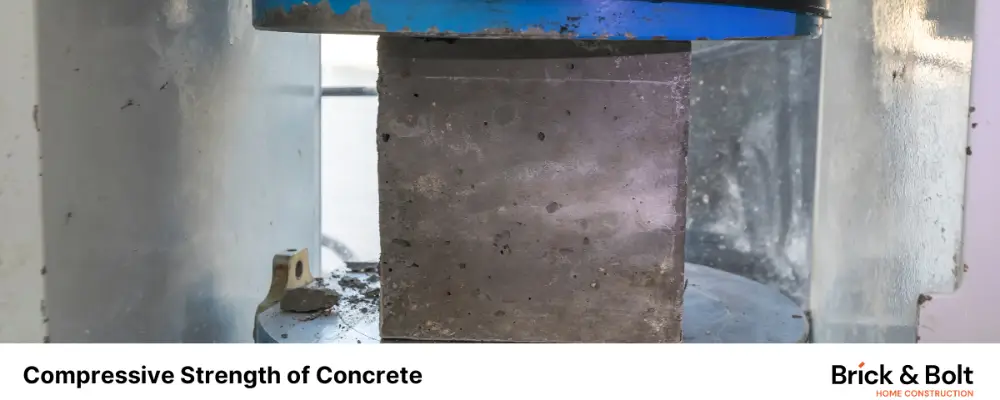No matter if you’re a builder or engineer, the common goal when building construction is the long-term stability of the structure. For that, the compressive strength of concrete plays a huge role, which determines how much weight or force it can handle before it breaks.
In general, the compressive strength of concrete ranges from 17.2 MPa to 27.6 MPa (approximately 2500 psi to 4000 psi). However, depending on the specific application and requirements, it can be increased to exceed 68.9 MPa (more than 10,000 psi). Let’s look at the compressive strength of concrete in detail.
What Exactly is the Compressive Strength of Concrete?
In simple terms, compressive strength is a measure of concrete’s ability to withstand axial loading. It is specifically determined from standard 150 mm x 150 mm x 150 mm cube samples tested at 28 days.
This strength is measured by testing machines in terms of Newton per millimeter square (N/mm²) or megapascals (MPa).
The formula to calculate compressive strength is fc = P/A.
- “P” is the maximum load applied
- “A” is the cross-sectional area of the specimen.
4 Main Factors that Impact Compressive Strength:
The strength and durability of concrete primarily depend upon the quality of materials used. These factors determine the ability of the structure to withstand heavy loads or burdens.
Below are the significant factors interrelated with compressive strength:
Quantity of Cement
The quantity of cement is an important factor that directly impacts the strength of the concrete. Mixing cement and water in the right proportion improves the concrete’s strength. If the cement ratio is less than the desired requirement, the structure’s strength will be reduced. Similarly, excessive cement can reduce bonding with coarse aggregates.
Material Quality
Making compromises in raw material quality affects the concrete strength.
Generally, fine aggregates are very fine particles used to fill the gaps among coarse aggregates. The higher the quality of fine aggregates, the greater the concrete strength can be achieved. If any impurities exist in it, the concrete can lose its strength.
Uneven Mixing
Proper mixing distributes all components (water, cement, admixtures) evenly throughout the structure. If not blended properly, cement can concentrate in one part of the mixture, reducing overall strength.
Concrete Curing
Curing is crucial to concrete strength development. For optimal results, concrete should be cured in a controlled environment for 28 days to prevent durability issues, shrinkage, and ensure proper strength development.
Strengths Varied On Concrete Type
Ordinary Concrete
Ordinary concrete’s compressive strength is between 20 and 40 MPa (2900 to 5800 psi), making it suitable for homes and commercial buildings.
High-Strength Concrete
The compressive strength of high-strength concrete is more than 40 MPa (5800 psi).
It can reach up to 140 MPa (14,500 psi) or more in certain applications. It is suitable for high-rise buildings, bridges, and other structures that need exceptional strength.
Concrete Grades and Their Strengths
Standard grades of concrete and their characteristic compressive strengths are specified as follows:
- M10: 10 N/mm²
- M15: 15 N/mm²
- M20: 20 N/mm²
- M25: 25 N/mm²
These grades signify the minimum compressive strength of concrete attainable at 28 days when tested.
Compressive Strength After 7 Days & 28 Days
Concrete gets stronger with time. On day 7, it typically reaches about 70% of its full strength, with its peak strength usually measured at 28 days.
| S.No | Minimum Age | Age Factor |
| 1 | 7 days | 0.7 |
| 2 | 28 days | 1.0 |
| 3 | 3 months | 1.1 |
| 4 | 6 months | 1.15 |
| 5 | 12 months | 1.2 |
Importance in Home Construction
A reliable home construction lies in having a high compressive strength of concrete.
The key points are as follows:
- It ensures the safety and longevity of the construction.
- It helps prevent structural failures, reduces maintenance costs, and increases the lifespan of the building.
- Quality control measures like regular testing and proper curing ensure the concrete meets required strength standards.
Best Practices for Achieving High Compressive Strength
Achieving high compressive strength involves several practices as follows:
1) Optimized Mix Design
- A balanced mix of water, cement, and aggregates can significantly improve the compressive strength.
- It also ensures the sufficient hydration of cement particles and improves particle distribution.
2) Optimal Water-Cement Ratio
- The well-proportioned water-cement ratio is a critical factor in achieving high compressive strength.
- Excess amounts of water cause weak bonds between cement particles that can negatively influence strength and durability.
3) Selecting Right Materials
- The quality of materials is everything that determines the strength of a construction project.
- It is crucial to ensure the cement and aggregates are clean and well-graded to offer structure-enhanced strength and durability.
On The Whole
The compressive strength of concrete is a critical factor in construction. By following the best practices we discussed and optimizing proper mix design, adequate curing, and conducting regular testing, the desired compressive strength can be achieved for various applications like buildings, bridges, and other concrete structures.
Home builders and engineers need to be aware of these things before involving any construction projects, and for accurate results, Brick & Bolt will be your trusted partner.
FAQs
The factors that influence the compressive strength of concrete are
mixing techniques,
water-cement ratio,
quality of aggregates used,
curing condition, and
cement type.
Yes, different types of concrete are used in construction based on requirements. They are high-strength, normal-weight, and lightweight concrete. Each has unique characteristics that determine an individual’s strength.

